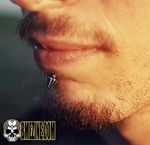|
|
| Line 1: |
Line 1: |
| | {| |
| | |- |
| | | [[File:Labret_Spike-1.jpg|150px|thumb|right|Labret Spike]] |
| | | [[File:Labret_Spike-2.jpg|150px|thumb|right|Labret Spike]] |
| | | [[File:Labret_Spike-3.jpg|150px|thumb|right|Labret Spike]] |
| | |} |
|
| |
|
|
| | A '''labret spike''' is simply a standard [[Labret stud|labret stud]] with a spike bead screwed onto the end rather than a normal round bead (although some designs are a single piece — simply a spike attached to a flat backing). It does not need special placement. Most people with labret spikes wear them for decorative reasons and do not wear them at all times. |
| The male urethra travels from the bladder through the prostate and length of the penis. It is relatively close to the surface all the way from the tip of the penis to between the scrotum and the anus. If a sound is inserted into the urethra and pressure is exerted, it is easy to see the skin tent up along that portion of the urethra. The major difference after that is in how the reroute is done. Many, including those who are DIY types, pierce through the urethra, creating a small hole to pee through. Others of us who have avoided the DIY mode, preferring instead to have some who knows their anatomy and what they are doing, cut and stitch. Even though it is a relatively simple procedure, the success level for those who have tried DIY, piercing a hole through and hoping it would work, is poor. Those who have gone through the surgical procedure, which can be done as an out-patient in about an hour, have had more success.
| |
|
| |
|
| It should be noted that due to the shortened urethra, men will be far more prone to bladder infections. This is doubly true because of the new proximity to the anus (cleanliness is essential). In addition, complications from the procedure including urethral stricture are not uncommon. Finally, contrary to popular belief, having a urethral reroute does not bypass the urethral sphincter, it just shortens the urethra. If proper hygiene is used, there should not be any types of complications.
| | Labret spikes are available in many different lengths, from cones not much larger than a round bead would be on up to long spikes inches in length. |
|
| |
|
| | | == Related Risks == |
| | | * [[Airbag]] |
| | |
| Urethral Reroute
| |
| | |
| Urethral Reroute
| |
| | |
| Urethral Reroute
| |
| | |
| Urethral Reroute<html><div class="mw-content-ltr" dir="ltr" id="mw-content-text" lang="en"><p>The male urethra travels from the <a href="/index.php?title=Bladder" title="Bladder">bladder</a> through the <a href="/index.php?title=Prostate" title="Prostate">prostate</a> and length of the <a href="/index.php?title=Penis" title="Penis">penis</a>. It is relatively close to the surface all the way from the tip of the penis to between the <a href="/index.php?title=Scrotum" title="Scrotum">scrotum</a> and the <a href="/index.php?title=Anus" title="Anus">anus</a>. If a <a class="mw-redirect" href="/index.php?title=Sound" title="Sound">sound</a> is inserted into the <a href="/index.php?title=Urethra" title="Urethra">urethra</a> and pressure is exerted, it is easy to see the skin tent up along that portion of the urethra. The major difference after that is in how the reroute is done. Many, including those who are DIY types, pierce through the urethra, creating a small hole to pee through. Others of us who have avoided the DIY mode, preferring instead to have some who knows their anatomy and what they are doing, cut and stitch. Even though it is a relatively simple procedure, the success level for those who have tried DIY, piercing a hole through and hoping it would work, is poor. Those who have gone through the surgical procedure, which can be done as an out-patient in about an hour, have had more success.
| |
| </p><p><br/>
| |
| It should be noted that due to the shortened urethra, men will be far more prone to bladder infections. This is doubly true because of the new proximity to the anus (cleanliness is essential). In addition, complications from the procedure including <a class="mw-redirect" href="/index.php?title=Urethral_stricture" title="Urethral stricture">urethral stricture</a> are not uncommon. Finally, contrary to popular belief, having a urethral reroute does not bypass the <a class="mw-redirect" href="/index.php?title=Urethral_sphincter" title="Urethral sphincter">urethral sphincter</a>, it just shortens the urethra. If proper hygiene is used, there should not be any types of complications.
| |
| </p><p><br/>
| |
| </p>
| |
| <table style="text-align: center;">
| |
| <tr>
| |
| <td> <div class="thumb tright"><div class="thumbinner" style="width:152px;"><a class="image" href="/index.php?title=File:Urethral_Reroute-1.jpg"><img alt="" class="thumbimage" height="113" src="/images/thumb/4/4f/Urethral_Reroute-1.jpg/150px-Urethral_Reroute-1.jpg" width="150"/></a> <div class="thumbcaption"><div class="magnify"><a class="internal" href="/index.php?title=File:Urethral_Reroute-1.jpg" title="Enlarge"><img alt="" height="11" src="/skins/common/images/magnify-clip.png" width="15"/></a></div>Urethral Reroute</div></div></div>
| |
| </td>
| |
| <td> <div class="thumb tright"><div class="thumbinner" style="width:152px;"><a class="image" href="/index.php?title=File:Urethral_Reroute-2.jpg"><img alt="" class="thumbimage" height="113" src="/images/thumb/6/60/Urethral_Reroute-2.jpg/150px-Urethral_Reroute-2.jpg" width="150"/></a> <div class="thumbcaption"><div class="magnify"><a class="internal" href="/index.php?title=File:Urethral_Reroute-2.jpg" title="Enlarge"><img alt="" height="11" src="/skins/common/images/magnify-clip.png" width="15"/></a></div>Urethral Reroute</div></div></div>
| |
| </td>
| |
| <td> <div class="thumb tright"><div class="thumbinner" style="width:152px;"><a class="image" href="/index.php?title=File:Urethral_Reroute-3.jpg"><img alt="" class="thumbimage" height="113" src="/images/thumb/1/16/Urethral_Reroute-3.jpg/150px-Urethral_Reroute-3.jpg" width="150"/></a> <div class="thumbcaption"><div class="magnify"><a class="internal" href="/index.php?title=File:Urethral_Reroute-3.jpg" title="Enlarge"><img alt="" height="11" src="/skins/common/images/magnify-clip.png" width="15"/></a></div>Urethral Reroute</div></div></div>
| |
| </td>
| |
| <td> <div class="thumb tright"><div class="thumbinner" style="width:152px;"><a class="image" href="/index.php?title=File:Urethral_Reroute-4.jpg"><img alt="" class="thumbimage" height="113" src="/images/thumb/7/78/Urethral_Reroute-4.jpg/150px-Urethral_Reroute-4.jpg" width="150"/></a> <div class="thumbcaption"><div class="magnify"><a class="internal" href="/index.php?title=File:Urethral_Reroute-4.jpg" title="Enlarge"><img alt="" height="11" src="/skins/common/images/magnify-clip.png" width="15"/></a></div>Urethral Reroute</div></div></div>
| |
| </td></tr></table>
| |
| | |
| | |
| </div></html>
| |


